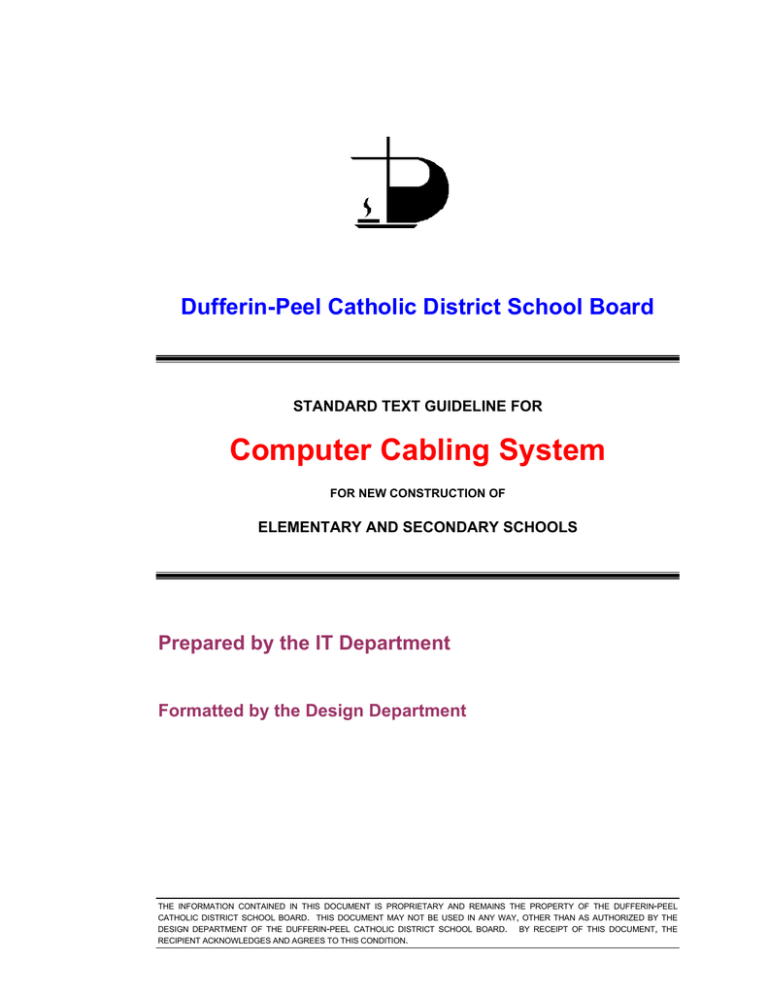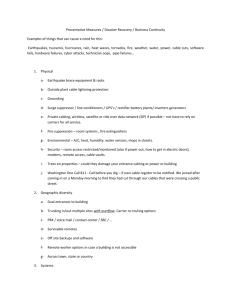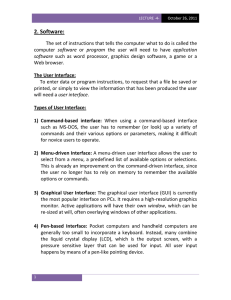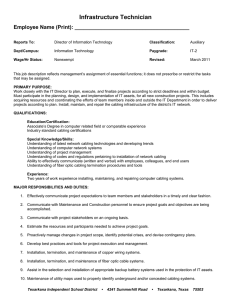Computer Cabling System Dufferin-Peel Catholic District School Board
advertisement

Dufferin-Peel Catholic District School Board STANDARD TEXT GUIDELINE FOR Computer Cabling System FOR NEW CONSTRUCTION OF ELEMENTARY AND SECONDARY SCHOOLS Prepared by the IT Department Formatted by the Design Department THE INFORMATION CONTAINED IN THIS DOCUMENT IS PROPRIETARY AND REMAINS THE PROPERTY OF THE DUFFERIN-PEEL CATHOLIC DISTRICT SCHOOL BOARD. THIS DOCUMENT MAY NOT BE USED IN ANY WAY, OTHER THAN AS AUTHORIZED BY THE DESIGN DEPARTMENT OF THE DUFFERIN-PEEL CATHOLIC DISTRICT SCHOOL BOARD. BY RECEIPT OF THIS DOCUMENT, THE RECIPIENT ACKNOWLEDGES AND AGREES TO THIS CONDITION. COMPUTER CABLING SYSTEM TABLE OF CONTENTS Elementary & Secondary Schools (Enhanced Category 5) 1 GENERAL ....................................................................................................................................... 1 1.1 SPECIAL NOTES ............................................................................................................................. 1 2 PURPOSE ...................................................................................................................................... 1 2.2 2.3 2.4 2.5 2.6 2.7 2.8 2.9 2.10 3 PRODUCTS .................................................................................................................................... 6 3.1 3.2 3.3 3.4 3.5 3.6 3.7 3.8 4 WORK INCLUDED ........................................................................................................................... 2 SUBMITTALS .................................................................................................................................. 2 QUALITY ASSURANCE..................................................................................................................... 2 SCOPE OF WORK ........................................................................................................................... 3 SYSTEM TESTING........................................................................................................................... 3 STANDARDS .................................................................................................................................. 3 WARRANTY ................................................................................................................................... 5 INSTALLATION WARRANTY .............................................................................................................. 5 CABLING SYSTEM WARRANTY ......................................................................................................... 5 REFERENCES ................................................................................................................................ 6 HORIZONTAL CABLING.................................................................................................................... 6 COPPER CABLE TERMINATIONS ...................................................................................................... 6 DATA OUTLETS .............................................................................................................................. 6 RACKMOUNT PATCH PANELS .......................................................................................................... 7 PATCH CORDS ............................................................................................................................... 8 RACKS .......................................................................................................................................... 8 ACCEPTABLE MANUFACTURERS ..................................................................................................... 9 EXECUTION ................................................................................................................................... 9 4.1 4.2 4.3 4.4 4.5 4.6 4.7 4.8 4.9 4.10 INSTALLATION OF CABLING - GENERAL ............................................................................................ 9 INSTALLATION OF PATCH PANELS AND ACCESSORIES .................................................................... 10 COPPER CABLE INSTALLATION ...................................................................................................... 10 PENETRATION THROUGH FIRE WALLS ........................................................................................... 11 INSTALLATION OF OUTLETS .......................................................................................................... 11 ELECTROMAGNETIC INTERFERENCE SEPARATION.......................................................................... 12 SYSTEM IDENTIFICATION .............................................................................................................. 12 CABLE IDENTIFICATION ................................................................................................................ 12 WIRE CENTRE CODE - PATCH PANEL AND PORT NUMBERS .............................................................. 13 CABLE TESTING AND SYSTEM CERTIFICATION ................................................................................ 13 i.) COMPUTER CABLING SYSTEM GUIDELINE Elementary & Secondary Schools (Enhanced Category 5) 1 GENERAL 1.1 SPECIAL NOTES 1.1.1 This is not a specification. It is a Guideline indicating typical wiring for the Computer Cabling System and is reproduced here for the information to the Consultants. 1.1.2 The wiring described herein for the Computer Cabling System is to be carried as an Allowance in the Contract Documents. 1.1.3 The Computer Cabling System is installed by Sub-Contractor(s) in direct contractual agreement with the Board, separate from the General Contract. 1.1.4 The conduit, back boxes, raceways, wiremold, cable troughs etc. to accommodate the Computer System and associated wiring, as described in both the Elementary and Secondary School Guidelines, Design Criteria and Fitments is, however, included in the Contract Documents. 1.1.5 It is the Consultant's responsibility to insure that these Guidelines are coordinated with the Contract Documents, in the appropriate sections. 2 PURPOSE 2.1.1 The intent of this document is to provide a standard guideline that will be used for all Elementary and Secondary Schools, both educational and administrative facilities requiring cabling installation. This Guideline provides the minimum performance criteria for the components and sub-systems comprising a complete cabling system that shall accommodate The DufferinPeel Catholic District School Board (The Board) infrastructure requirements in excess of ten years. 2.1.2 Product specifications, general design considerations, and installation guidelines are provided in this written document. Typical quantities of Telecommunications outlets, typical installation details, and cable routing are defined in the Board’s Design Criteria & Fitments Guidelines. 2.1.2.1 2.1.3 A schedule of actual quantities and locations for any specific educational facility will be provided as an attachment to this document by the design firm. If the bid documents are in conflict, the written specification shall take precedence. The successful vendor shall meet or exceed all requirements for the cabling system described in this document. The Board’s cable infrastructure project requires an AMP 110 CONNECT System structured cabling system. If all requirements are complied with, the cabling system shall be backed by an AMP 25-Year Performance Warranty. The performance warranty shall be facilitated by the Contractor and be established between AMP and the Board. Page 1 of 13 GUIDELINE COMPUTER CABLING SYSTEM Elementary & Secondary Schools (Enhanced Category 5) 2.1.4 2.2 2.2.1 2.3 The successful contractor is required to furnish all labour, supervision, tooling, and miscellaneous mounting hardware and consumables for the cabling system installed excluding the network electronics. The contractor shall maintain current “Good” status as a TE CONNECTIVITY Design and Installation (ND&I) contractor, including all training requirements, for the duration of the project. The Contractor shall staff each installation crew with the appropriate number of trained personnel, in accordance with their AMP ND&I contract agreement, to support the 25-Year Performance Warranty requirements. After installation, the Contractor shall submit all documentation to support the warranty requirements in accordance with the warranty requirements, and to apply for said warranty on behalf of the Board. The warranty will cover the components and labour associated with the repair/replacement of any defective link within the warranty period, when the defect is a valid warranty claim. WORK INCLUDED Comply with Electrical General Provision Section 16010 and all other documents referred therein. SUBMITTALS 2.3.1 Submit shop drawings for equipment and accessories specified in this Section. 2.3.2 Submit complete cabling system layout drawings and manufacturers component literature. Include manufacturer’s literature on cabling, jacks, faceplates, terminal cabinets, etc. and cabling test sheets. Cabling shop drawings and data sheets must be reviewed and approved by the Board’s Network Department prior to ordering. 2.3.3 The cabling system layout, routing and design must be approved by a RCDD (Registered Communications Distribution Designer). The design shall meet or exceed BICSI (Building Industry Consulting Services International) standards. RCDD registration number must be included. 2.3.4 Submit samples of jacks, faceplates and cabling with shop drawings. Do not order components unless approved by the Board’s Network Department. 2.3.5 Prepare and submit “As-Built” drawings approved by a Registered Communications Distribution Designer (RCDD). RCDD registration number must be included. 2.4 2.4.1 QUALITY ASSURANCE All companies shall be CSA and for ULC approved listed and labeling. Page 2 of 13 COMPUTER CABLING SYSTEM GUIDELINE Elementary & Secondary Schools (Enhanced Category 5) 2.5 SCOPE OF WORK 2.5.1 This Guideline defines the cabling system and subsystem components to include cable, termination hardware, supporting hardware, and miscellany required to furnish and install a complete cabling infrastructure supporting voice, data, and video. 2.5.2 The intent of this Guideline is to provide pertinent information to allow the vendor to bid the labour, supervision, tooling, materials, and miscellaneous mounting hardware and consumables to install a complete system. However, it is the responsibility of the vendor to propose any, and all, items required for a complete system whether or not it is identified in the specification, drawings and bill of materials attached to this Guideline. 2.6 2.5.2.1 Provision of cabling system for the compete networking of a school which can support the use of intelligent switching HUBS with Network Management capabilities. 2.5.2.2 Organized wiring in a structured cabling system using point to point distribution system incorporating modular terminations. 2.5.2.3 Provisions of horizontal cable to workstations, data communications outlets patch panels and associated equipment. SYSTEM TESTING 2.6.1 The local area network system must be “protocol neutral” and provide users access into a variety of resources from any locations within the school. An Ethernet backbone shall be utilized for the system with intelligent switches coordinating and managing data flow. The wiring configuration is based on a “physical star” topology in which cabling runs emanate in a radial pattern from the main data communications room. (Server Room) 2.6.2 Technical features of the structural cabling plan include: 2.7 2.7.1 2.6.2.1 The use of Enhanced Category 5, cabling to each workstation. 2.6.2.2 Use of modular Enhanced Category 5 jacks at both ends of cabling runs. 2.6.2.3 Use of 50/125m Multimode Fiber OM3 for inter-closet link greater than 90m. The jacket colour shall be aqua with SC style terminations end to end. 2.6.2.4 All inter closet links must contain 2 physical “homerun” tie lines whether it is copper or fiber depending distance. STANDARDS The cabling system described in this Guideline is derived in part from the recommendations made in industry standard documents. The list of documents below have bearing on the desired cabling infrastructure and are incorporated into this Guideline by reference: Page 3 of 13 COMPUTER CABLING SYSTEM GUIDELINE Elementary & Secondary Schools (Enhanced Category 5) 2.7.2 This Technical Guideline and Associated Drawings: 2.7.2.1 ANSI/TIA-C.0, Generic Telecommunications Customer Premises, and its published addenda. Cabling 2.7.2.2 ANSI/TIA-568-C.1, Commercial Building Telecommunications Cabling Standard and its published addenda. 2.7.2.3 ANSI/TIA-568-C.2, Copper Cabling Components Standard, and its published addenda. 2.7.2.4 ANSI/TIA-568-C.3, Optical Fiber Standard, and its published addenda. 2.7.2.5 ANSI/TIA/EIA-569-B, Commercial Standard for Telecommunications Pathways and Spaces, and its published addenda. 2.7.2.6 ANSI/TIA/EIA-606-B, Administration Standard for the Telecommunications Infrastructure of Commercial Buildings, and its published addenda. 2.7.2.7 ANSI/J-STD-607-B, Commercial Building Grounding (Earthing) and Bonding Requirements for Telecommunications, and its published addenda. 2.7.2.8 ANSI/TIA-942, Telecommunications Infrastructure Standard for Data Centres, and its published addenda 2.7.2.9 Building Industries Consulting Services International (BICSI) Telecommunications Distribution Methods Manual 12th Edition (TDMM) – 1966. Cabling for Components 2.7.2.10 National Fire Protection Agency (NFPA) – 70, National Electrical Code (NEC) – 2011. 2.7.2.11 TE CONNECTIVITY Agreement (current). Design and Installation Contractor 2.7.3 If a conflict exists between applicable documents, then the order in the list above shall dictate the order of precedence in resolving conflicts. This order of precedence shall be maintained unless a lesser order document has been adopted as code by a Local, Provincial or Federal Authority Having Jurisdiction. If a conflict exists, documents adopted as code shall take precedence. 2.7.4 If this document and any of the documents listed above are in conflict, then the more stringent requirement shall apply. All documents listed are believed to be the most current releases of the documents, the vendor is responsible to determine and adhere to the most recent release when developing the proposal for installation. 2.7.5 All work must be installed by system manufacturers certified systems installers/vendors who are certified and experienced in implementing the Page 4 of 13 COMPUTER CABLING SYSTEM GUIDELINE Elementary & Secondary Schools (Enhanced Category 5) selected data cabling system and to perform related testing programs. Dates of certification of both installers and company must be submitted. 2.7.6 2.8 2.8.1 2.9 2.9.1 The cabling system layout must be performed by a RCDD and defined by Building Industry Consulting Service International (BICSI). WARRANTY The contractor shall provide a system warranty covering the installed cabling system against defects in workmanship, components, and performance, and follow-on support after project completion for a period of one year. INSTALLATION WARRANTY The contractor shall warrant the cabling system against defects in workmanship for a period of one year from the date of system acceptance by the Board. (The customer/designer will need to define terms of acceptance the bidders will need to meet.) The warranty shall cover all labour and materials necessary to correct a failed portion of the system and to demonstrate performance within the original installation specifications after repairs are accomplished. This warranty shall be provided at no additional cost to the Board. 2.10 CABLING SYSTEM WARRANTY 2.10.1 The Contractor shall facilitate the 15-Year Performance Warranty between AMP Incorporated and the Board. The performance warranty shall warrant properly installed 100 MHz horizontal copper and both the horizontal and the backbone optical fiber portions of the cabling system. Copper links shall be warranted against the link performance minimum expected results as defined in the TIA/EIA 568A, TSB-67, and the AMP ND&I Contractor Agreement. Fiber optic links shall be warranted against the link and segment performance minimum expected results defined in the TIA/EIA 568A, Annex H and the AMP ND&I Contractor Agreement. 2.10.2 The system manufacturers shall provide a minimum twenty five (25) year performance warranty on all passive components including the structural cabling system. These warranties shall be provided in written certificate form. 2.10.3 The system manufacturers shall provide in writing to the owner that in event of the demise or failure of the installing certified system installer, the manufacturer shall be responsible for providing another certified system installer/vendor to fulfill the remainder of the warranty conditions. 2.10.4 The contractor shall provide a guaranteed twenty-four (24) hour response time to any warranty claims. 2.10.5 Contractors must ensure that the selected network cabling component manufacture and the wiring manufacture must have contractual relationships to ensure that the system warranty is a true “end to end” structured cabling system warranty. Page 5 of 13 COMPUTER CABLING SYSTEM GUIDELINE Elementary & Secondary Schools (Enhanced Category 5) 3 PRODUCTS 3.1 3.1.1 3.2 3.2.1 REFERENCES Refer to appropriate Sections 16100. HORIZONTAL CABLING The horizontal cabling to workstations shall be FT6 (i.e. suitable for use in plenum environments), UTP cal and shall comply with EIA/TIA TSB-36 requirements for Enhanced Category 5. The cable specification shall be: 3.2.1.1 Conductors: 4 pair, 24 AWG solid copper conductors, unshielded twisted pair. 3.2.1.2 Cable grade: Enhanced Category 5 3.2.1.3 Overall sheath: FT6 rated, blue coloured outer sheath 3.2.1.4 Worst pair near end crosstalk loss <32 dB/1000 ft. (32 dB/300 M) @ 100 Hz. 3.2.1.5 Maximum mutual capacitance: 17 pF/ft. (17pF/300M). 3.2.1.6 D.C. resistance: 28.6 ohms/1000ft (28.6 ohms.300 M) 3.2.1.7 Fitted impedance 100+/-5 at 1 MHZ and 100 ± 3 from 4 to 100 MHZ. 3.2.1.8 Maximum signal attenuation: 67dB/1000 ft. (67 dB/300 M) @ 100 MHz 3.2.1.9 Maximum length: 300 ft. (90 m) ok. 3.2.1.9.1 Manufacturers: TE Conductivity Enhanced Category 5 cables (TE520P-BL02) 3.2.2 Backbone links under 90 m shall be FT6 Copper as above. Backbone links over 90 m shall be multimode fibre. 3.2.3 The backbone links over fibre shall be FT6 (i.e. suitable for use in plenum environments), using 50/125m multimode cable. TE Connectivity #31553312-9 (12 strand) 3.3 3.3.1 3.4 3.4.1 COPPER CABLE TERMINATIONS The “Structured Cabling Plan” is an end to end solution, which includes the data communications outlet, patch cord at the workstation, patch panel and patch cords at the HUB Room. DATA OUTLETS Modular outlets shall meet the following specification: Page 6 of 13 COMPUTER CABLING SYSTEM GUIDELINE Elementary & Secondary Schools (Enhanced Category 5) 3.4.1.1 Workstation outlets shall be of a type that will support multiple data and telecommunications systems interface requirements without re-termination of the building wiring. 3.4.1.2 Adaptation to communications equipment requirements shall be through the use of adapter inserts that provide the required connector interface. 3.4.1.3 Connection of the outlet to twisted pair building wiring shall be through 110-style contacts which will terminate 22-26 AWG solid or stranded conductors. 3.4.2 Work area jacks shall be comprised of TE Connectivity Enhanced Category 5, Unshielded jacks SL Series AMP #1375191-2 Black with strand relief caps AMP #1375200-2. 3.4.3 Flush wall mounting faceplate to fit on a single gang recessed outlet box shall be plastic or stainless steel as appropriate: Stainless Steel 2-port Flush Faceplate - 1FM-00E-AMP Stainless Steel 4-port Flush Faceplate - 1FM-(4)0E-AMP Stainless Steel 6-port Flush Faceplate - 1FM-(6)0E-AMP 3.4.4 Enhanced Category 5 Certified. 3.4.5 Complete with labelling provisions. 3.4.6 Unused Faceplate ports shall be blanked off with 110Connect Multimedia Blank Insert - 406339-1. 3.5 RACKMOUNT PATCH PANELS 3.5.1 Patch panels, which terminate horizontal twisted pair distribution cables, shall mount on an EIA standard 490 mm (19") equipment rack. 3.5.2 Copper patch panels shall be TE CONNECTIVITY Enhanced Category 5 Patch Panels SL Series, AMP part #: 12 port – 1479153-2, 24 port – 1479154-1, 48 port – 1479155-2. 3.5.3 Fiber patch panels shall be AMP 2 or 4U rack-mount enclosure as required for strand count. 2U Rack Mount Enclosure, Unloaded with Plastic Front Door SC Duplex Multimode Snap in Plate Blank Snap in Adapter Plate 3.5.4 Fiber jacks shall be SC Duplex type using SC 6-Fibre Multimode OM3 SC snap-in adjustable plate 559516-1. Page 7 of 13 COMPUTER CABLING SYSTEM GUIDELINE Elementary & Secondary Schools (Enhanced Category 5) 3.5.5 The patch panel system shall include all required accessories such as bezels, connectors, jumpers and retaining rings, interlay racking panels, horizontal wire managers etc. to provide for patch cord management. 3.5.6 Each patch panel shall be provided with a horizontal cable management panel. This panel shall be AMP part number 558329-1. 3.5.7 Patch panels installed in the main network closet cabinet must be mounted 4U from the top of the cabinet rails. 3.5.8 All copper tie lines from closets and lab are to be terminated in the main LAN cabinet on a separate patch panel mounted above the rest of the patch panel for regular data drops. 3.6 PATCH CORDS 3.6.1 Copper patch cords shall be TE CONNECTIVITY patch cables, No. 24 AWG stranded copper, Enhanced Category 5, ISDN wired, at the patch panel end. Provide patch cords in lengths specified in the Board” Design Guidelines. 3.6.2 Provide a total quantity of wire centre patch cords to match the number of horizontal cable runs. Provide a total quantity of workstation patch cords to match the number of horizontal cable runs. 3.6.3 Fibre patch cords shall be AMP SC-LC Multimode 50/125 m or approved equivalent. 3.6.3.1 3.6.4 3.7 Reserved. Patch cords shall be in two lengths depending on location: 3.6.4.1 For computer labs, two patch cords shall be provided with each drop installed; one @ 600 mm (2 ft.) length and one @ 900 mm (3 ft.) length. 3.6.4.2 For all other locations, two patch cords shall be provided with each drop installed; one @ 900 mm (3 ft.) length and one @ 2,140 mm (7 ft.) length. RACKS 3.7.1 All Patch Panels will be housed in full-size standard communications cabinets or wall-mounted swing-out cabinets as specified for the location. Unless specified otherwise, the primary wiring centre shall be equipped with a fullsize standard communications cabinet and all secondary wire centers will be located in a wall mounted swing-out cabinet. 3.7.2 A standard full-size communications cabinet shall be one of the following specifications: 3.7.2.1 (Width x Depth x Height) = 30” x 42” x 83” 3.7.2.2 2 pairs of Cage Nut rails (1pair mounted in the front and the other pair in the back) Page 8 of 13 COMPUTER CABLING SYSTEM GUIDELINE Elementary & Secondary Schools (Enhanced Category 5) 3.7.3 3.7.4 3.8 100 Cage nuts 3.7.2.4 Two (2) Vertical power strips 3.7.2.5 Two (2) side panels 3.7.2.6 Two (2} doors (1 front and 1 back) 3.7.2.7 One (1) pair of vertical cable management rails on the back A standard wall-mounted swing-out cabinet shall be one of the following specifications: 3.7.3.1 (Width x Depth x Height) = 28” x 25” x 23” 3.7.3.2 Standard 19” EIA Mounting Angles with 10-32 tapped holes 3.7.3.3 Vertical Cable Management A standard wall mounted low profile cabinet shall consist of the following: 3.7.4.1 Panduit PANZONE PZAEWM3 Active Wall mount Enclosure 3.7.4.2 Or equivalent pre-approved by the Board ICT department ACCEPTABLE MANUFACTURERS 3.8.1 3.8.2 4 3.7.2.3 Acceptable network cabling component and wiring manufacturers shall include the following companies: 3.8.1.1 TE CONNECTIVITY 3.8.1.2 RF MOTE 3.8.1.3 PANDUIT 3.8.1.4 HUBBLE All LAN cabinets, racks and enclosures are subject to approval by the Board prior to purchase and installation. EXECUTION 4.1 INSTALLATION OF CABLING - GENERAL 4.1.1 All cables must be properly handled and installed in accordance with the manufacture specifications. Undue pulling tension, abrasion or rough handling must be avoided to ensure that the cables will permit transmission up to the design speed of 100 Mb/s. 4.1.2 All cables must be installed without splices or cuts to ensure the elimination of reflections, discontinuities, impedance mismatches, etc. The maximum horizontal length from the workstation to the HUB shall not exceed 90 m (300 ft.) 4.1.3 Wiring shall be mechanically protected by runs in cable tray or down drops in conduits. Page 9 of 13 COMPUTER CABLING SYSTEM GUIDELINE Elementary & Secondary Schools (Enhanced Category 5) 4.1.4 4.2 4.2.1 4.3 Examination of the work site conditions should be completed before installation commences. If any discrepancies exist, report them to the Board. Installation of any part of the work will be construed as acceptance of such conditions as being satisfactory. INSTALLATION OF PATCH PANELS AND ACCESSORIES Provide patch panels onto racks in locations as shown by the design firm in the attached schedule. Provide terminating hardware and connectors to suit incoming an outgoing cabling. Clearly identify each port. Install all devices in accordance with system manufactures requirements. COPPER CABLE INSTALLATION 4.3.1 All horizontal UTP cables shall be continuous from end to end with no splices. Horizontal cables shall be installed in Star topology, emanating from the rack mounted patch panel(s) and terminating on data outlet faceplates in classrooms or other workstation locations. The maximum length for horizontal cables shall not exceed 90 m (300 ft.). The maximum length for patch cords at workstations shall not exceed 7,650 mm (25 ft.) The maximum length for patch cords at the patch panel shall not exceed 3,000 mm (10 ft.). 4.3.2 Unless otherwise noted, all horizontal cabling shall be installed in conduit, or run in a cable tray. 4.3.3 The following criteria must be met for conduit installation: 4.3.4 4.3.3.1 For straight runs up to 17 m (50 ft.), the cables may occupy up to 40% of the conduit area. 4.3.3.2 For conduit runs between 17 m (50 ft.) and 30 m (100 ft.) the cables may occupy up to 33% of the conduit area. 4.3.3.3 For runs over 30 m (100 ft.) the cables shall not exceed 25% of the conduit area. 4.3.3.4 Each 90 degree conduit bend shall be considered as the equivalent of two (2) @ 90o bends exist in the conduit run or if the run exceed 60 m (200 ft.). 4.3.3.5 A pull box must be installed when more than the equivalents of two (2) @ 90o bends exist in the conduit run or if the run exceeds 60 m (200 ft.). Cables and conduits shall be installed following building lines. Under no circumstances shall cables or conduits be fastened to suspended ceiling support systems. Cables and conduits shall be supported to building structure independent of other systems. 4.3.4.1 Page 10 of 13 All conduit systems shall be left with a nylon fish string to allow for future cables. COMPUTER CABLING SYSTEM GUIDELINE Elementary & Secondary Schools (Enhanced Category 5) 4.4 4.3.4.2 Bending radius shall not be tighter than four (4) times the cable diameter. 4.3.4.3 Terminations shall involve as little outer jacket removal as possible and cable pairs “untwisting” shall not exceed ½” (13 mm). 4.3.4.4 Slack cable must be provided to allow for minor workstation relocations. A coil of slack cable of an approximate 6 ft. (2 m) length shall be provided above workstation locations. PENETRATION THROUGH FIRE WALLS 4.4.1 A conduit sleeve shall be provided where horizontal cables penetrate firewalls. The conduit sleeve shall be sized at 40% fill ratio with a plastic bushing at both ends. 4.4.2 After the conduit sleeve is installed, the opening around the conduit shall be filled with ULC listed fire stop and mask seal material. 4.5 INSTALLATION OF OUTLETS 4.5.1 Cables shall be coiled in the in-wall or surface-mount boxes if adequate space is present to house the cable coil without exceeding the manufacturers bend radius. 4.5.2 In hollow wall installations where box-eliminators are used, excess wire can be stored in the wall. No more than 12” of slack shall be stored in an in-wall box, modular furniture raceway, or insulated walls. 4.5.3 Excess slack may be neatly coiled and stored in the ceiling above each drop location when there is not enough space present in the outlet box to store slack cable. 4.5.4 Cables shall be dressed and terminated in accordance with the recommendations made in the TIA/EIA-568-B document, manufacturer’s recommendations and/or best industry practices. 4.5.5 Each drop shall receive one 4 pair, Enhanced Category 5, FT 6 rated cable. Each cable shall be tested and identified with the faceplate also identified. All jacks shall be wired and connected back to respective patch panels. 4.5.6 Terminations shall involve as little outer jacket removal as possible and cable pairs “untwisting” shall not exceed 13mm (0.5”). 4.5.7 Bend radius of the cable in the termination area shall not be less than 4 times the outside diameter of the cable. 4.5.8 The cable jacket shall be maintained as close as possible to the termination point. 4.5.9 Voice jacks, unless otherwise noted in drawings, shall be located in the bottom position(s) of each faceplate. Voice jacks in horizontally oriented Page 11 of 13 COMPUTER CABLING SYSTEM GUIDELINE Elementary & Secondary Schools (Enhanced Category 5) faceplates shall occupy the right-most position(s). considered the last voice jack in the sequence. Modem jacks shall be 4.5.10 Data jacks shall occupy the top position(s) on the faceplate. Data jacks in horizontally oriented faceplates shall occupy the left-most position(s). 4.6 4.6.1 4.7 4.7.1 4.8 ELECTROMAGNETIC INTERFERENCE SEPARATION All data communication cables shall be separated from sources of electromagnetic radiation in accordance with TIA Standard proposal SP-2072 and the following: 4.6.1.1 If both data and small power cables (2 KVA power circuits) are installed in grounded, ferrous metal conduit throughout the run, then no separation is required (i.e. EMT conduit). 4.6.1.2 FT-6 rated data cabling with no metallic raceway and power conductors (2 KVA power circuits) in grounded raceway requires 125 mm (5”) clearance. 4.6.1.3 For fluorescent fixtures, the required clearance is 300 mm (12”). 4.6.1.4 Clearance increased up to 610 mm (24”) for power circuits over 5 KVA. 4.6.1.5 For large motor, transformer, power panels, etc, the required clearance is 1,020 mm (40”) 4.6.1.6 Cables must be routed to avoid direct contact with steam piping, hot water piping or other heat sources to avoid thermal degradation. SYSTEM IDENTIFICATION A complete identification n system shall be provided that clearly designates the following: 4.7.1.1 The wire centre 4.7.1.2 The patch panel 4.7.1.3 The patch panel port CABLE IDENTIFICATION 4.8.1 Each Wire Centre shall be identified with a letter code starting with the primary wire centre as code ‘A’. The ports of each individual patch panel will be designated numerically starting with ‘1’. 4.8.2 Horizontal UTP cables shall be permanently identified at the faceplate end in the following manner. Page 12 of 13 COMPUTER CABLING SYSTEM GUIDELINE Elementary & Secondary Schools (Enhanced Category 5) 4.9 WIRE CENTRE CODE - PATCH PANEL AND PORT NUMBERS 4.9.1 EXAMPLE: A cable terminating in Wire Centre A, port #12 shall be designated as A-12. 4.9.2 All cable runs from LAN closets (Tie Lines) must be terminated on a separate patch panel in the main LAN rack. This patch panel shall only have, “Tie Line” drops terminations from various LAN closets in the building. 4.9.3 Cable runs between patch panels shall be identified at each end with the designation of the opposite end as per above. 4.9.4 Identification Log: 4.9.4.1 4.9.5 All cable and workstations shall be recorded in a hard copy “CABLE IDENTIFICATION LOG” which is to be handed over to the School Board or Information Systems Manager after cable testing and certification is complete. A duplicate copy is to be retained on site in the completed building. As-built: 4.9.5.1 Prepare “As Built” drawings to detail exact location of equipment and indicating wiring runs, raceways, pull boxes, junction boxes, terminal boxes, outlet location, cable numbers and equipment rack profiles. 4.10 CABLE TESTING AND SYSTEM CERTIFICATION 4.10.1 The structured cabling system certification shall include 100% cable testing and verification for 100 Mb/s solution. 4.10.2 The verification of each cable shall be performed by the contractor and shall be documented on a cable test sheet that shall form part of a hard copy documentation supplied at the end of the installation. 4.10.3 A detailed one-page cable test documentation sheet shall be provided for each cable run. Testing shall include, but not be limited to the following: 4.10.3.1 Cable length 4.10.3.2 Attenuation 4.10.3.3 Near end crosstalk (NEXT) 4.10.3.4 Noise 4.10.3.5 Resistance 4.10.3.6 Wire Map 4.10.4 Cable test results must be sent to Dufferin-Peel ICT Network Services after completion of the work. Page 13 of 13 COMPUTER CABLING SYSTEM GUIDELINE Elementary & Secondary Schools (Enhanced Category 5) END OF COMPUTER CABLING SYSTEM GUIDELINE LATEST REVISION IN BLUE FONT DATE ISSUED JULY 2000 REVISION 1 MAY 2002 REVISION 2 OCTOBER 2008 REVISION 3 NOV 2015 E:\DATA\WORD\TECHNICAL TEXT\DPCDSB COMPUTER CABLING SYSTEM.DOC Page 14 of 13




